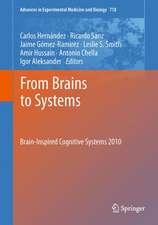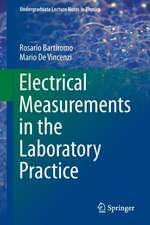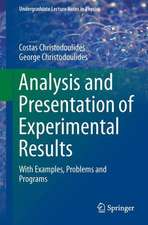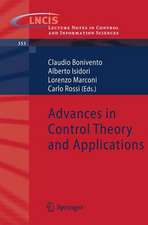Control of Complex Systems
Editat de Karl J. Aström, Pedro Albertos, Mogens Blanke, Alberto Isidori, Walther Schaufelberger, Ricardo Sanzen Limba Engleză Paperback – 27 sep 2012
| Toate formatele și edițiile | Preț | Express |
|---|---|---|
| Paperback (1) | 954.14 lei 6-8 săpt. | |
| SPRINGER LONDON – 27 sep 2012 | 954.14 lei 6-8 săpt. | |
| Hardback (1) | 959.36 lei 6-8 săpt. | |
| SPRINGER LONDON – 16 oct 2000 | 959.36 lei 6-8 săpt. |
Preț: 954.14 lei
Preț vechi: 1163.58 lei
-18% Nou
Puncte Express: 1431
Preț estimativ în valută:
182.60€ • 189.93$ • 150.74£
182.60€ • 189.93$ • 150.74£
Carte tipărită la comandă
Livrare economică 14-28 aprilie
Preluare comenzi: 021 569.72.76
Specificații
ISBN-13: 9781447110743
ISBN-10: 1447110749
Pagini: 500
Ilustrații: XII, 482 p.
Dimensiuni: 155 x 235 x 26 mm
Greutate: 0.69 kg
Ediția:Softcover reprint of the original 1st ed. 2001
Editura: SPRINGER LONDON
Colecția Springer
Locul publicării:London, United Kingdom
ISBN-10: 1447110749
Pagini: 500
Ilustrații: XII, 482 p.
Dimensiuni: 155 x 235 x 26 mm
Greutate: 0.69 kg
Ediția:Softcover reprint of the original 1st ed. 2001
Editura: SPRINGER LONDON
Colecția Springer
Locul publicării:London, United Kingdom
Public țintă
ResearchCuprins
1. Introduction.- 1.1 Complex Systems and Control.- 1.2 Complex Engineering Systems.- 1.3 The Role of Feedback.- 1.4 Dynamics and Control.- 1.5 The Nature of Failures.- 1.6 Research Challenges.- 1.7 About the Book.- 2. Modeling Complex Physical Systems.- 2.1 Introduction.- 2.2 The Modelica Project.- 2.3 Composition Diagrams.- 2.4 Modelica Details.- 2.5 Non-causal Modeling.- 2.6 Advanced Modeling Features.- 2.7 Standard Libraries.- 2.8 Future Development.- 2.9 Conclusions.- 3. Passivity-based Control of Non-linear Systems.- 3.1 Introduction.- 3.2 Passivity and Stability Analysis of Feedback Interconnections.- 3.3 Feedback Passivity and Stabilization.- 3.4 Euler-Lagrange Systems.- 3.5 Disturbance Attenuation and R oo Control.- 4. An Introduction to Forwarding.- 4.1 Introduction.- 4.2 C1 Dissipative Systems.- 4.3 C1 Dis sipative Systems via Reduction or Extension.- 4.4 Exact Change of Coordinates.- 4.5 Approximate Change of Coordinates.- 5. Iterative Identification and Control Design.- 5.1 Introduction.- 5.2 Youla Parametrization.- 5.3 A Generic Two-degree of Freedom Controller.- 5.4 Optimization of the Generic Scheme.- 5.5 A New Closed-loop System Parametrization.- 5.6 Asymptotic Variances for K-B-Parametrization.- 5.7 Iterative Controller Refinement.- 5.8 Robustness and Sensitivity.- 5.9 Product Inequalities.- 6. Learning Control of Complex Systems.- 6.1 Introduction.- 6.2 Model Structures for Learning.- 6.3 Control Structures for Learning.- 6.4 Learning Paradigms.- 6.5 A General Framework for On-line Learning.- 6.6 Validation.- 6.7 Conclusions.- 7. Software for Complex Controllers.- 7.1 Introduction.- 7.2 An Evolving Paradigm.- 7.3 Emerging Software Concepts.- 7.4 On to Standardization.- 7.5 Sample Complex Software Controllers.- 7.6 The Future of Software for Control.-8. Fault-tolerant Control Systems.- 8.1 Introduction.- 8.2 Basic Definitions.- 8.3 Analysis of Fault Propagation.- 8.4 Analysis of Structure.- 8.5 Recoverability.- 8.6 Autonomous Fault-tolerant Control.- 8.7 An Example: Ship Propulsio.- 8.8 Summary.- 9. Fault Detection and Isolation.- 9.1 The Principle of Model-based Fault Diagnosis.- 9.2 Signal-based FDI Approach.- 9.3 Quantitative Model-based FDI Approach.- 9.4 Qualitative Model-based FDI Approach.- 9.5 Summary.- 10. Residual Generation for FDI in Non-linear Systems.- 10.1 Introduction.- 10.2 Algebraic Approach.- 10.3 Geometric Approach.- 10.4 Conclusion.- 11. Predictive Methods for FTC.- 11.1 Introduction.- 11.2 Predictive Control.- 11.3 Embedding Fault Tolerance in Predictive Control.- 11.4 Model Adaptation and Management.- 11.5 Modifying Control Objectives.- 11.6 Current Industrial Practice.- 11.7 Conclusions.- 12. Three-tank Control Reconfiguration.- 12.1 The Benchmark Problem.- 12.2 Reconfigurability Analysis.- 12.3 Reconfiguration Based on a Qualitative Model.- 12.4 A Hybrid Approach to Reconfigurable Control.- 12.5 A Multi-model-based Reconfigurable Control.- 12.6 A Neural Observer-based Approach.- 12.7 Conclusions.- 13. Ship Propulsion Control and Reconfiguration.- 13.1 Introduction.- 13.2 Ship Propulsion System.- 13.3 Structural Analysis.- 13.4 Fault Detection: A Fuzzy Observer Approach.- 13.5 Fault Detection: Non-linear Approach - 1.- 13.6 Fault Detection: Non-linear Approach - 2.- 13.7 Reconfiguration Using Software Redundancy.- 13.8 Reconfiguration Using Predictive Control.- 13.9 Summary and Conclusions.- 14. Learning Control of Thermal Systems.- 14.1 Introduction.- 14.2 On Thermal System Learning Control.- 14.3 Controlling Kiln Heat Processing.- 14.4 Controlling Reheat Furnace Processes.- 14.5 Hierarchical Control for Quality Ceramic Tiles.- 14.6 Learning Control ofFBC Combustion.- 14.7 Conclusions and Future Research.- 15. Vibration Control of High-rise Buildings.- 15.1 Introduction.- 15.2 Energy and Information.- 15.3 Analytical Mechanics and HRB Modelling.- 15.4 Disturbance Decoupling.- 15.5 Passivity Based Control.- 15.6 Engineering Constraints and Feedback.- 15.7 Feedback Control and Testing.- 15.8 Conclusions and Future Research.- 16. Control of Helicopters.- 16.1 Introduction.- 16.2 Project History.- 16.3 The COSY Program.- 16.4 Hardware System.- 16.5 Software.- 16.6 Design of the Autopilot.- 16.7 Future Development.- 16.8 Conclusions.- 17. Satellite Attitude Control.- 17.1 Introduction to the Attitude Control Problem.- 17.2 Fault-tolerant Control of the 0RSTED Satellite.- 17.3 Stabilization of the Angular Velocity of a Rigid Body.- 17.4 Optimal Slew Maneuvers via Geometric Control Theory.- 17.5 Attitude Control using Magnetorquers as Sole Actuators.- 17.6 Predictive Attitude Control of Small Satellites.- 17.7 Attitude Determination without Sensor Redundancy.- 17.8 Summary.- Appendix A. List of Contributors.- Appendix B. List of Abbreviations.- References.
Caracteristici
All the leading lights in European non-linear control, fault identification and fault tolerance have contributed to this work The book introduces ideas from research groups purposely set up to be multidisciplinary in nature Case studies based on well-known problems are given an up to date treatment

























